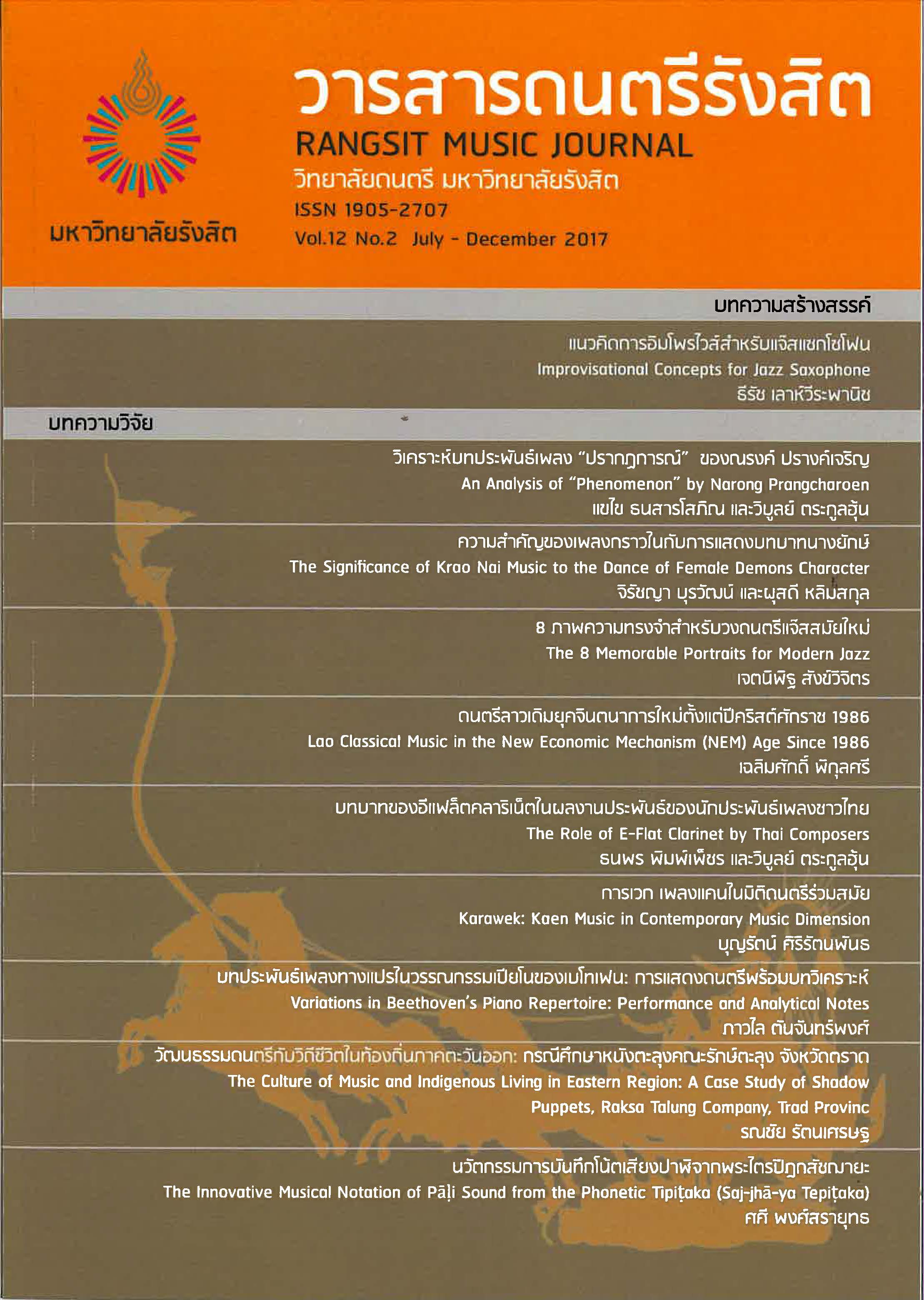Lao Classical Music in the New Economic Mechanism (NEM) Age Since 1986
Keywords:
Lao Music, Lao Classical Music, New Economic Mechanism (NEM) AgeAbstract
The purpose of this research study was to investigate changes in Lao classical music, both in terms of musical elements and context, after Lao People’s Democratic Republic’s transformation of economic policy from absolute socialism to the New Economic Mechanism (NEM) under the concept of one country with two regimes, meaning that the country adopted socialism as its political system and capitalism as its economic system. Field data were collected in Vientiane and Luang Phrabang. Results of the study indicated since Lao People’s Democratic Republic’s adoption of the absolute socialism in 1975, Lao classical music, which was considered a symbol of feudal system under the concept of socialism, had been neglected and not promoted, resulting in the discontinuation of its development. As a result of its absolute socialism policy, the national development in every area was slow and even prevented; therefore, the government later announced the New Economic Mechanism (NEM) and had adopted capitalism as it economic system since 1986, especially after the construction of the “Thai-Lao Friendship Bridge” in 1994. Laos was opened to its neighboring countries, especially Thailand. Its opening up to the world resulted in its rapid growth and development and many significant changes. This study revealed that changes in music were different between Vientiane and Luang Phrabang. It was found that in Vientiane, many musical instruments were ordered from or provided by Thailand to replace the ones broken due to lack of care and maintenance during the socialism period. Concerning musical performance techniques, it was found that new generation of Lao musicians and music teachers usually studied the techniques from Thai musicians via television programs, Youtube, DVDs and VCDs. However, in Luang Phrabang, a UNESCO World Heritage Site, there was an attempt to revive and create Lao identities. It was found that a new musical instrument, representing Laos’ unique identity, was created. People were more interested in learning Lao traditional style of musical performance. Regarding the roles of music, it was found that learning of Lao music both in Vientiane and Luang Phrabang was primarily focused on meeting tourism business whereas the music aimed at serving the traditional way of life of Laotians tended to decrease.
References
2. คำรุ่ง แสนมนี และคณะ. “รายงานการค้นคว้าเรื่องพื้นเวียงสมัยเจ้าอนุ.” เวียงจันทน์: คณะอักษรศาสตร์ มหาวิทยาลัยแห่งชาติลาว, 2004.
3. จุลจอมเกล้าเจ้าอยู่หัว, พระบาทสมเด็จพระ. พระราชวิจารณ์จดหมายเหตุกรมหลวงนรินทรเทวี (พ.ศ. 2310-2380), พิมพ์ครั้งที่ 5. พระนคร: โรงพิมพ์พระจันทร์, 2509.
4. มหาสีลา วีระวงศ์. ประวัติศาสตร์ลาว. แปลโดย สมหมาย เปรมจิตต์. เชียงใหม่: สถาบันวิจัยสังคม มหาวิทยาลัยเชียงใหม่, 2535.
5. มหาอำมาตยาธิบดี, พระยา. ตำนานเมืองนครจำปาศักดิ์ ประชุมพงศาวดาร เล่ม 43. กรุงเทพฯ: องค์การค้าครุสภา, 2512.
6. พรรคประชาชนปฏิวัติลาว. เอกสารกองประชุมใหญ่ ครั้งที่ 7. เวียงจันทน์: โรงพิมพ์แห่งรัฐ, 2001.
7. สินทะวง พมทิเดท (ผู้ให้สัมภาษณ์). เฉลิมศักดิ์ พิกุลศรี (ผู้สัมภาษณ์) โรงเรียนศิลปะแห่งชาติ นครหลวงเวียงจันทน์ สปป. ลาว. เมื่อวันที่ 25 เมษายน พ.ศ. 2559.
8. อ่อนจัน สุดาดอง (ผู้ให้สัมภาษณ์). เฉลิมศักดิ์ พิกุลศรี (ผู้สัมภาษณ์). โรงละครพระลัก-พระลาม เมืองหลวงพระบาง สปป. ลาว. เมื่อวันที่ 17 เมษายน พ.ศ. 2558.
9. Gay, Patrick. Treasure from Laos. Vientiane: Institute de Researches sur la Culture, Lao (I.R.C.L), 1998.
10. Marx, Karl. and Frederick Engels. On the Literature and Art. MosCo : Progress Publisher, 1978.
11. Rattanavong, H. and Siripaphanh, B. Treasures of Luangprabang. Vientiane: The National Committee, 1989.
Downloads
Published
How to Cite
Issue
Section
License
กองบรรณาธิการฯ สงวนสิทธิ์ในการพิจารณาและตอบรับการตีพิมพ์ ความรับผิดชอบใดๆ เกี่ยวกับเนื้อหาและความคิดเห็นในบทความเป็นของผู้เขียนต่อบทความนั้นๆ กองบรรณาธิการฯ ไม่ต้องรับผิดชอบ



